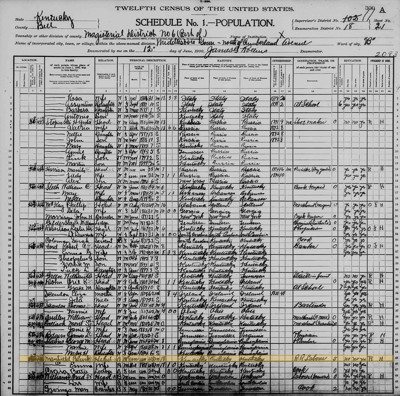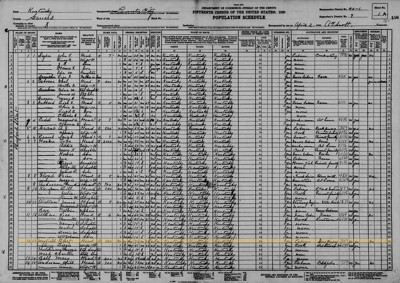

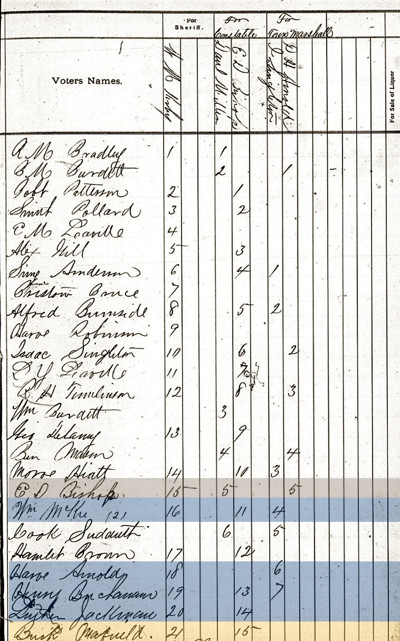
The final page of the August 1876 Lancaster poll book, showing Bert “Buck” Mayfield’s vote (highlighted in yellow), other black men who voted with him (in blue), and Ed Bishop, candidate for constable (in brown).
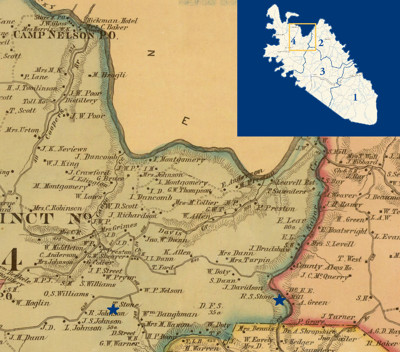
Edited detail from the 1879 Beers and Lanagan map, which shows Smith Thomas Stone’s properties, inherited by his sons Thomas and Robert upon his death in 1875. Bert Mayfield likely grew up on the mixed crop farm inherited by Thomas, though he also probably spent a good deal of time at the sugar plantation inherited by Robert.
University of Wisconsin-Milwaukee Libraries.
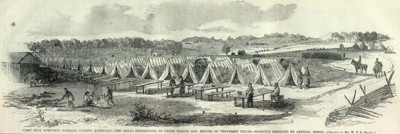
An illustration of Camp Dick Robinson by W.T.R Brown.
Published in Harper’s Weekly, November 1, 1862.
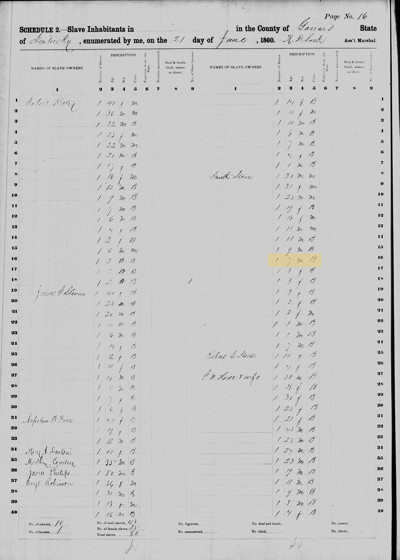
1860 U.S. Census slave schedule, showing the ages and sexes of people enslaved in Garrard County. Listed as Smith Stone’s property are 17 people, including a 7-year-old boy who is probably Bert Mayfield.

Page from the 1870 U.S. Census, showing Bert “Bunk” Mayfield living with Cain Hodgens and his family.
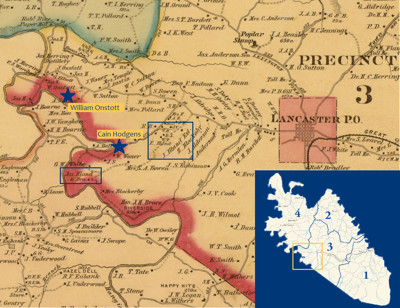
Edited detail from the 1879 Beers and Lanagan map, which shows where Bert Mayfield lived in the late 1860s (with William Onstott) and in 1870 (in Cathole Bend with Cain Hodgens) as well as the land holdings of the Bland family.
University of Wisconsin-Milwaukee Libraries.
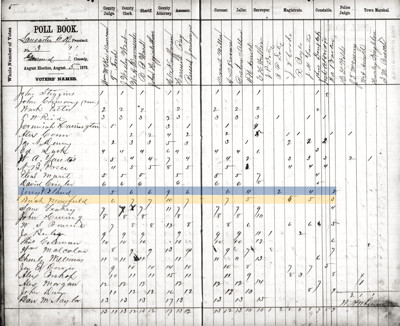
A final page of the August 1878 Lancaster poll book, showing Bert “Buck” Mayfield’s vote (highlighted in yellow) and Jeremiah P. Blands vote (in blue).
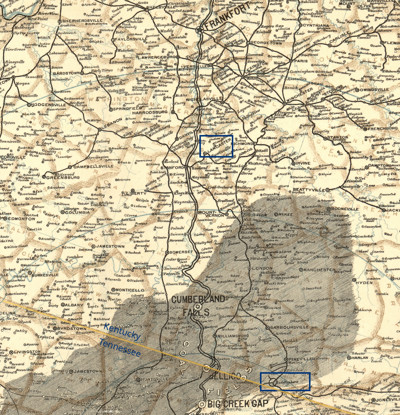
Detail from the Boones map of the Black Diamond System of Railways showing the railways and coal fields in Kentucky and the towns of Lancaster and Middlesboro.
1896, courtesy of the Library of Congress.
Bert Mayfield:
Coming of Age During a Time of Profound Change
As the last light of day was rapidly leaving the sky, a young black man of 22 or 23 years ascended the stairs of the Lancaster courthouse on August 7, 1876, to participate in his first county election. Bert Mayfield, who often went by the nickname “Buck,” declared his vote for incumbent Republican sheriff, William Kirby, who faced no opposition, and Edward D. Bishop for constable.
Bert was the last man of the day to vote. He voted in a group mostly made up of black men. This group was perhaps organized by Bishop, a young politician who had won the affections of the town during a cholera outbreak in 1873 and who, in 1882, would stand trial for intimidating a black voter during the November congressional election. Bishop announced his choices at the head of the group. Although a Democrat, Bishop voted for the unopposed Republican for sheriff, and, as was customary at the time, his Republican opponent for constable. Five black men, including Mayfield, followed, none of whom voted for Bishop's opponent (Republican Dan Miller).
In the Lancaster voting district, the August 1876 election was not at all competitive. However, it stirred the passions of Lancaster’s African American community, which was still reeling from the cholera epidemic (which took black victims at twice the rate of white) and from August 1874’s election riot, in which many black men were killed. African American men turned out in Lancaster in far greater numbers than white men.
In this story, we explore the life of a man too young to have served in the Civil War. Unlike the other men we follow—James Anderson, Henry Mason, and Phillip Dunn—who were enslaved until the served in the military, Mayfield gained his freedom as a teenager. He is also one of only a few black men in Garrard County to have voted for the Democratic Party in the 1870s.
Like many black men of his generation, Mayfield left Garrard County as a young man to explore opportunities farther afield, and so we cannot track his political participation all the way until 1891. After working on the railroads near the Tennessee border, he ultimately returned to Garrard County, passing away there in 1941.
Bert’s enslaved beginnings
Bert Mayfield was a young boy of seven or eight when the Civil War broke out. He grew up on Smith Thomas Stone’s 203-acre farm near the site that would become the Union’s first base south of the Ohio River, Camp Dick Robinson. Stone was reputedly a Whig and a supporter of the Union. Yet, in 1860, he is listed as owning 17 people in Garrard County, with his eldest son, Robert Smith Stone, owning two more people. In 1870, Smith Thomas Stone and his younger son, Thomas Smith Stone, voted the straight Democratic Party ticket together.
Freedom as a teenager
Mayfield was interviewed for the Slave Narrative Project in the 1930s. He explained that he “received the first news of freedom joyfully” in 1865, when Bert would have been about 11 years old.
The next few decades, from teenagerhood into young adulthood, would be filled with transition.
Soon after freedom, Mayfield moved in with William Onstott. Onstott was a white Republican and a wealthy farmer in his sixties who had never owned any slaves. He was married to Smith T. Stone’s eldest surviving daughter, Esther. They lived on a 140-acre farm on the banks of the Dix River. Mayfield likely stayed there only a few years, getting his bearings in the confusion and elation that immediately followed emancipation.
At least one other of the Stone family’s former slaves lived with the Onstotts after gaining her freedom: Belle Stone, a 13-year-old girl, resided with them when the census collector came by 1870. Likely others made a base there during the exciting, but daunting, transition from enslavement to freedom. No doubt they, like Mayfield, quickly moved on, eager to start new, free, lives.
By 1870, Mayfield had moved just down the road from Onstott’s farm to a neighborhood now known as “Cathole Bend.” The area was dominated by the Bland family, who owned almost 3,000 acres along the Dix River, but it was also an area where many black farmers owned small plots of land.
Mayfield was 16 and working on the farm of Cain Hodgens, one of those black farmers with a small plot of land. Hodgens’ farm was worth $200 according to the 1870 census, making him one of the wealthiest black men in the county. Hodgens and Mayfield were likely related; they may have even been brothers. Mayfield’s death certificate lists his mother as “Matha Huggins,” a common variant spelling of Hodgens, but we have not been able to find any information about her.
We don’t know how long Mayfield stayed with the Hodgens family, but we do know that he remained in the Cathole Bend area until at least August 1878, because he voted then at the nearby Lancaster courthouse—for the Democratic Party ticket.
Voting the Democratic Ticket
After his last-minute foray into voting in August 1876, Mayfield was one of only four black men to vote the Democratic Party ticket in Lancaster on August 5, 1878.
Notably, Mayfield voted with his white neighbor, Jeremiah P. Bland. The Bland family owned much of the land in Cathole Bend. They had owned several people before the war. It may have been that Bland employed Mayfield on his land. He may have encouraged—perhaps rather forcefully—Mayfield to come with him to the polls with him and declare his votes for the Democratic Party. Of course, Mayfield might also have genuinely preferred the Democratic Party candidates who stood for powerful law enforcement offices like county judge and sheriff. That, we will never know.
Leaving Garrard County
Reflecting the upheaval of the time, we lose track of Mayfield in official records until 1900. We do not have any record of Mayfield voting after the 1878 election and he does not appear anywhere in the 1880 Census. Records of the 1890 Census were destroyed in a fire in 1921.
Mayfield moved to neighboring Lincoln County sometime between 1878 and 1882. Cain Hodgens and his family had moved across the Dix River to Lincoln County and were enumerated there, without Mayfield, in 1880. Spencer Hubble, with whom Mayfield recalled living when he got married around 1882, also lived in that same area of Lincoln County.
Mayfield and his new wife, Emma, might have had a tumultuous time at the Hubble residence. Emma bore a child while they lived there, but it did not survive. Hubble, a middle-aged white farmer who married his “49th cousin” after a 15-year courtship had some serious mental health issues and would be declared insane and committed in 1896. Hubble died in 1899, and his widow moved in with her family in Hustonville, just 15 miles south.
We don’t know whether Bert was an active political participant while he lived in Lincoln County. Poll books are our way inside Garrard County politics of the 1880s, and none survive for Lincoln County. It may be that Bert continued to vote in each county election, and perhaps for Democrat candidates.
In any case, the Mayfields didn’t settle down permanently in Lincoln County. They were soon on the move again.
By 1900, Bert and Emma Mayfield had moved a hundred miles away to Middlesboro, in Bell County on the border with Tennessee. Bert was working there on the railroads, which were rapidly developing to transport coal, iron ore, and limestone from local mines. The family had likely moved to Bell County that year for work, as the 1900 Census lists him as being unemployed for five months in the previous year.
Returning to Garrard County
For the next 30 years, there’s no record of Bert and Emma. When Bert re-surfaces in the official records, it’s 1930 and he is back in Garrard County. Living in Lancaster, with a new wife, Lizzie, and her two teenage children. Bert owned his own home, valued at $500, and, even in his 70s, was still working at the local quarry. It was only a few years before his death in 1941 that Mayfield was interviewed as part of the Slave Narrative Project, which has immortalized his memories (through the lens of 1930s attitudes) of his childhood on Stone family properties.


